2009 GMC CANYON key
[x] Cancel search: keyPage 1 of 414

Seats and Restraint System............................. 1-1
Front Seats
............................................... 1-2
Rear Seats
..............................................1-10
Safety Belts
.............................................1-13
Child Restraints
.......................................1-35
Airbag System
.........................................1-62
Restraint System Check
............................1-77
Features and Controls..................................... 2-1
Keys
........................................................ 2-3
Doors and Locks
....................................... 2-6
Windows
.................................................2-11
Theft-Deterrent Systems
............................2-14
Starting and Operating Your Vehicle
...........2-18
Mirrors
....................................................2-37
OnStar
®System
......................................2-41
Storage Areas
.........................................2-44
Sunroof
..................................................2-46
Instrument Panel............................................. 3-1
Instrument Panel Overview
.......................... 3-4
Climate Controls
......................................3-18
Warning Lights, Gages, and Indicators
........3-20
Driver Information Center (DIC)
..................3-35
Audio System(s)
.......................................3-42
Driving Your Vehicle....................................... 4-1
Your Driving, the Road, and the Vehicle
....... 4-2
Towing
...................................................4-40Service and Appearance Care.......................... 5-1
Service
..................................................... 5-3
Fuel
......................................................... 5-5
Checking Things Under
the Hood
.............................................5-10
Rear Axle
...............................................5-43
Four-Wheel Drive
.....................................5-44
Front Axle
...............................................5-45
Headlamp Aiming
.....................................5-47
Bulb Replacement
....................................5-47
Windshield Wiper Blade Replacement
.........5-52
Tires
......................................................5-54
Appearance Care
...................................5-100
Vehicle Identi�cation
...............................5-107
Electrical System
....................................5-108
Capacities and Speci�cations
...................5-115
Maintenance Schedule..................................... 6-1
Maintenance Schedule
................................ 6-2
Customer Assistance Information.................... 7-1
Customer Assistance and Information
........... 7-2
Reporting Safety Defects
...........................7-14
Vehicle Data Recording and Privacy
...........7-16
Index.................................................................1
2009 GMC Canyon Owner ManualM
Page 37 of 414
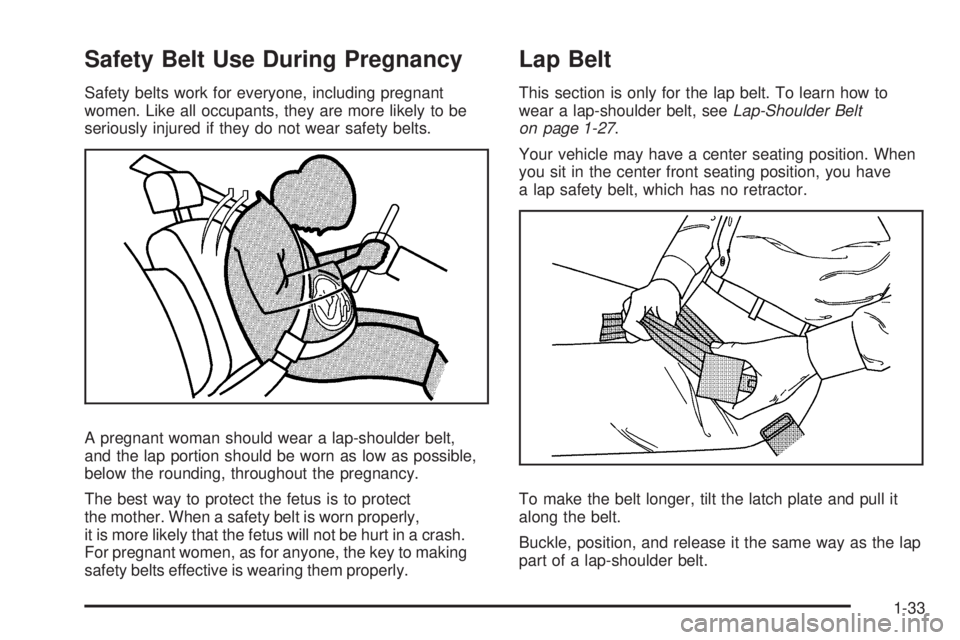
Safety Belt Use During Pregnancy
Safety belts work for everyone, including pregnant
women. Like all occupants, they are more likely to be
seriously injured if they do not wear safety belts.
A pregnant woman should wear a lap-shoulder belt,
and the lap portion should be worn as low as possible,
below the rounding, throughout the pregnancy.
The best way to protect the fetus is to protect
the mother. When a safety belt is worn properly,
it is more likely that the fetus will not be hurt in a crash.
For pregnant women, as for anyone, the key to making
safety belts effective is wearing them properly.
Lap Belt
This section is only for the lap belt. To learn how to
wear a lap-shoulder belt, seeLap-Shoulder Belt
on page 1-27.
Your vehicle may have a center seating position. When
you sit in the center front seating position, you have
a lap safety belt, which has no retractor.
To make the belt longer, tilt the latch plate and pull it
along the belt.
Buckle, position, and release it the same way as the lap
part of a lap-shoulder belt.
1-33
Page 83 of 414

Keys...............................................................2-3
Remote Keyless Entry (RKE) System................2-4
Remote Keyless Entry (RKE) System
Operation...................................................2-4
Doors and Locks.............................................2-6
Door Locks....................................................2-6
Power Door Locks..........................................2-7
Programmable Automatic Door Locks................2-7
Rear Door Security Locks (Crew Cab)...............2-8
Lockout Protection..........................................2-8
Rear Doors (Extended Cab).............................2-9
Tailgate........................................................2-9
Windows........................................................2-11
Manual Windows..........................................2-12
Power Windows............................................2-12
Sliding Rear Window.....................................2-13
Sun Visors...................................................2-13
Theft-Deterrent Systems..................................2-14
Content Theft-Deterrent.................................2-14
Passlock
®(U.S. Only)...................................2-15
PASS-Key®III+ Electronic Immobilizer.............2-16
PASS-Key®III+ Electronic Immobilizer
Operation (Canada Only)............................2-16Starting and Operating Your Vehicle................2-18
New Vehicle Break-In....................................2-18
Ignition Positions..........................................2-18
Retained Accessory Power (RAP)...................2-19
Starting the Engine.......................................2-20
Engine Coolant Heater..................................2-21
Automatic Transmission Operation...................2-22
Manual Transmission Operation......................2-25
Four-Wheel Drive..........................................2-26
Parking Brake..............................................2-31
Shifting Into Park (Automatic
Transmission)...........................................2-32
Shifting Out of Park (Automatic
Transmission)...........................................2-34
Parking the Vehicle (Manual
Transmission)...........................................2-34
Parking Over Things That Burn.......................2-35
Engine Exhaust............................................2-35
Running the Vehicle While Parked..................2-36
Section 2 Features and Controls
2-1
Page 85 of 414
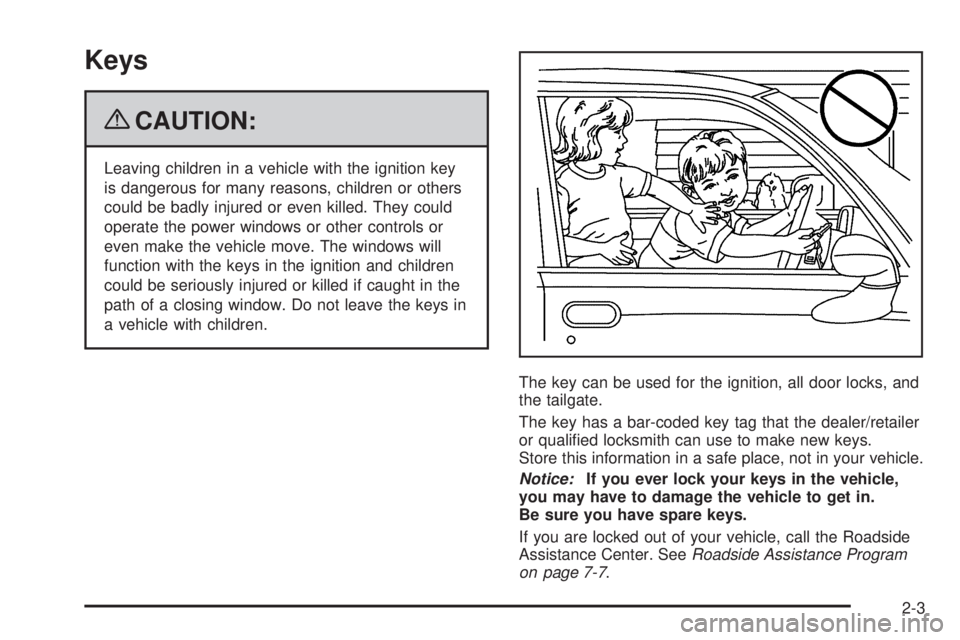
Keys
{CAUTION:
Leaving children in a vehicle with the ignition key
is dangerous for many reasons, children or others
could be badly injured or even killed. They could
operate the power windows or other controls or
even make the vehicle move. The windows will
function with the keys in the ignition and children
could be seriously injured or killed if caught in the
path of a closing window. Do not leave the keys in
a vehicle with children.
The key can be used for the ignition, all door locks, and
the tailgate.
The key has a bar-coded key tag that the dealer/retailer
or quali�ed locksmith can use to make new keys.
Store this information in a safe place, not in your vehicle.
Notice:If you ever lock your keys in the vehicle,
you may have to damage the vehicle to get in.
Be sure you have spare keys.
If you are locked out of your vehicle, call the Roadside
Assistance Center. SeeRoadside Assistance Program
on page 7-7.
2-3
Page 86 of 414
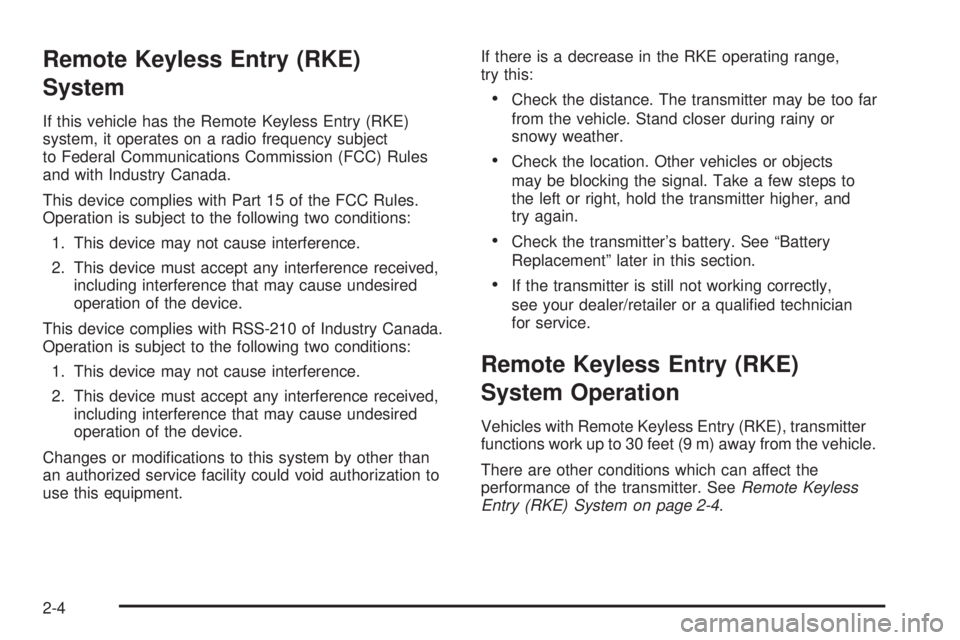
Remote Keyless Entry (RKE)
System
If this vehicle has the Remote Keyless Entry (RKE)
system, it operates on a radio frequency subject
to Federal Communications Commission (FCC) Rules
and with Industry Canada.
This device complies with Part 15 of the FCC Rules.
Operation is subject to the following two conditions:
1. This device may not cause interference.
2. This device must accept any interference received,
including interference that may cause undesired
operation of the device.
This device complies with RSS-210 of Industry Canada.
Operation is subject to the following two conditions:
1. This device may not cause interference.
2. This device must accept any interference received,
including interference that may cause undesired
operation of the device.
Changes or modi�cations to this system by other than
an authorized service facility could void authorization to
use this equipment.If there is a decrease in the RKE operating range,
try this:
Check the distance. The transmitter may be too far
from the vehicle. Stand closer during rainy or
snowy weather.
Check the location. Other vehicles or objects
may be blocking the signal. Take a few steps to
the left or right, hold the transmitter higher, and
try again.
Check the transmitter’s battery. See “Battery
Replacement” later in this section.
If the transmitter is still not working correctly,
see your dealer/retailer or a quali�ed technician
for service.
Remote Keyless Entry (RKE)
System Operation
Vehicles with Remote Keyless Entry (RKE), transmitter
functions work up to 30 feet (9 m) away from the vehicle.
There are other conditions which can affect the
performance of the transmitter. SeeRemote Keyless
Entry (RKE) System on page 2-4.
2-4
Page 87 of 414

UNLOCK:Press to unlock
the driver door and turn on
the interior lamps. The
parking lamps may �ash
and the horn may sound.
Press UNLOCK again within three seconds and all of
the doors unlock.
LOCK:Press to lock all the doors. The parking lamps
may �ash and the horn may sound.
If a door is open or ajar when LOCK is pressed, the
horn sounds several times to let you know the doors did
not lock and the content theft-deterrent system is not
armed. Pressing LOCK again while the horn is sounding
or within three seconds after the horn stops sounding,
the doors lock but the content theft-deterrent system
does not arm until the opened door is closed.Different feedback modes can be programmed through
the Driver Information Center (DIC). See “Remote
Keyless Entry Feedback” underDIC Operation and
Displays on page 3-35.
L(Panic):Press to make the horn sound and the
headlamps and taillamps �ash for up to 30 seconds.
To turn them off wait for 30 seconds, or press
Lagain,
or start the vehicle.
Programming Transmitters to
the Vehicle
Only RKE transmitters programmed to the vehicle will
work. If a transmitter is lost or stolen, a replacement
can be purchased and programmed through your
dealer/retailer. When the replacement transmitter is
programmed to the vehicle, all remaining transmitters
must also be programmed. Any lost or stolen
transmitters no longer work once the new transmitter
is programmed. Each vehicle can have up to
four transmitters programmed to it.
2-5
Page 89 of 414
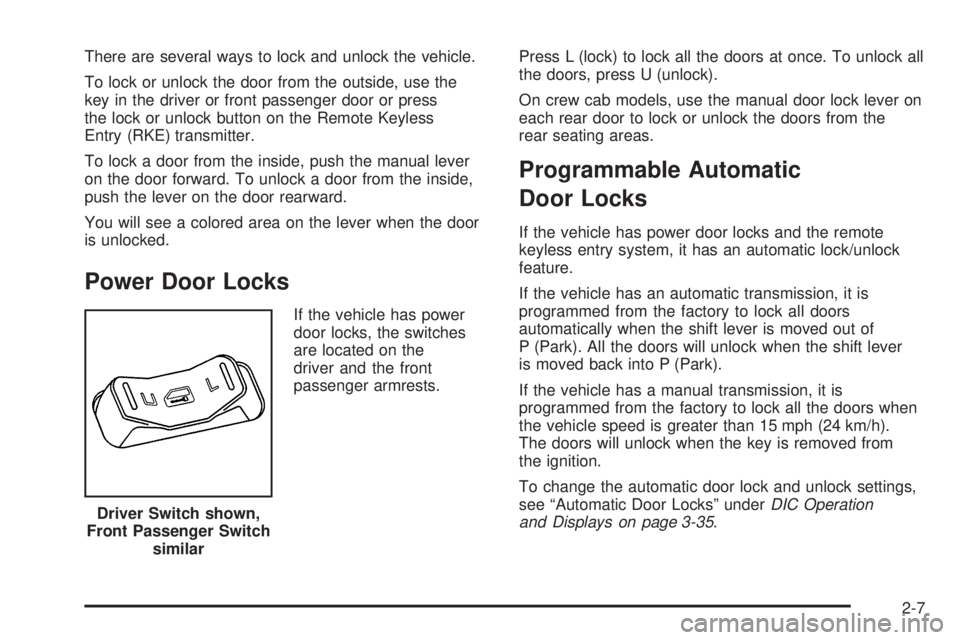
There are several ways to lock and unlock the vehicle.
To lock or unlock the door from the outside, use the
key in the driver or front passenger door or press
the lock or unlock button on the Remote Keyless
Entry (RKE) transmitter.
To lock a door from the inside, push the manual lever
on the door forward. To unlock a door from the inside,
push the lever on the door rearward.
You will see a colored area on the lever when the door
is unlocked.
Power Door Locks
If the vehicle has power
door locks, the switches
are located on the
driver and the front
passenger armrests.Press L (lock) to lock all the doors at once. To unlock all
the doors, press U (unlock).
On crew cab models, use the manual door lock lever on
each rear door to lock or unlock the doors from the
rear seating areas.
Programmable Automatic
Door Locks
If the vehicle has power door locks and the remote
keyless entry system, it has an automatic lock/unlock
feature.
If the vehicle has an automatic transmission, it is
programmed from the factory to lock all doors
automatically when the shift lever is moved out of
P (Park). All the doors will unlock when the shift lever
is moved back into P (Park).
If the vehicle has a manual transmission, it is
programmed from the factory to lock all the doors when
the vehicle speed is greater than 15 mph (24 km/h).
The doors will unlock when the key is removed from
the ignition.
To change the automatic door lock and unlock settings,
see “Automatic Door Locks” underDIC Operation
and Displays on page 3-35. Driver Switch shown,
Front Passenger Switch
similar
2-7
Page 90 of 414
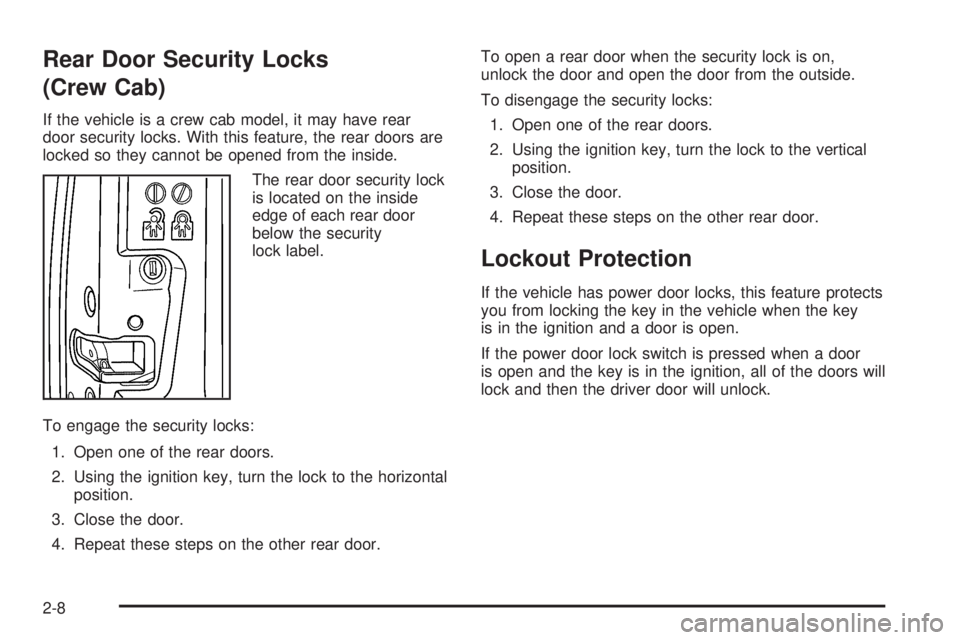
Rear Door Security Locks
(Crew Cab)
If the vehicle is a crew cab model, it may have rear
door security locks. With this feature, the rear doors are
locked so they cannot be opened from the inside.
The rear door security lock
is located on the inside
edge of each rear door
below the security
lock label.
To engage the security locks:
1. Open one of the rear doors.
2. Using the ignition key, turn the lock to the horizontal
position.
3. Close the door.
4. Repeat these steps on the other rear door.To open a rear door when the security lock is on,
unlock the door and open the door from the outside.
To disengage the security locks:
1. Open one of the rear doors.
2. Using the ignition key, turn the lock to the vertical
position.
3. Close the door.
4. Repeat these steps on the other rear door.
Lockout Protection
If the vehicle has power door locks, this feature protects
you from locking the key in the vehicle when the key
is in the ignition and a door is open.
If the power door lock switch is pressed when a door
is open and the key is in the ignition, all of the doors will
lock and then the driver door will unlock.
2-8